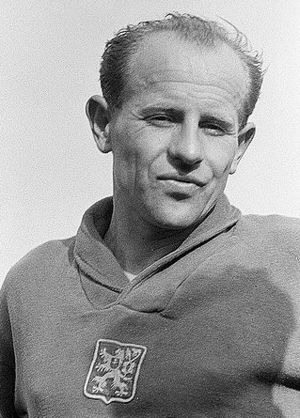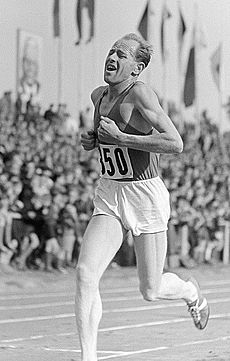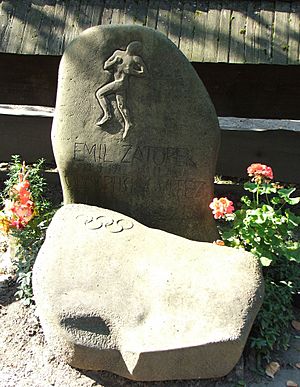Emil Zátopek facts for kids

Zátopek in 1951
|
|||||||||||||||||||||||||||||||||||||||||
Quick facts for kids Personal information |
|||||||||||||||||||||||||||||||||||||||||
|---|---|---|---|---|---|---|---|---|---|---|---|---|---|---|---|---|---|---|---|---|---|---|---|---|---|---|---|---|---|---|---|---|---|---|---|---|---|---|---|---|---|
| Nickname(s) | Czech Locomotive, Ťopek | ||||||||||||||||||||||||||||||||||||||||
| Born | 19 September 1922 Kopřivnice, Moravia, Czechoslovakia |
||||||||||||||||||||||||||||||||||||||||
| Died | 21 November 2000 (aged 78) Prague, Czech Republic |
||||||||||||||||||||||||||||||||||||||||
| Height | 1.82 m | ||||||||||||||||||||||||||||||||||||||||
| Weight | 72 kg | ||||||||||||||||||||||||||||||||||||||||
| Sport | |||||||||||||||||||||||||||||||||||||||||
| Sport | Long-distance running | ||||||||||||||||||||||||||||||||||||||||
| Club | TJ Gottwaldov, Zlín Dukla Praha |
||||||||||||||||||||||||||||||||||||||||
| Achievements and titles | |||||||||||||||||||||||||||||||||||||||||
| Personal best(s) | 5000 metres: 13:57.0 10,000 metres: 28:54.2 Marathon: 2:23:04 |
||||||||||||||||||||||||||||||||||||||||
|
Medal record
|
|||||||||||||||||||||||||||||||||||||||||
Emil Zátopek (born September 19, 1922 – died November 21, 2000) was a famous Czech long-distance runner. He is best known for winning three gold medals at the 1952 Summer Olympics in Helsinki. He won gold in the 5,000 metres and 10,000 metres races. His third gold medal came when he decided at the last minute to run in the first marathon of his life. People called him the "Czech Locomotive" because he ran so fast and powerfully.
In 1954, Zátopek was the first runner ever to finish the 10,000 metres race in under 29 minutes. Three years before that, in 1951, he ran 20 kilometers in less than an hour. Many people think he was one of the greatest runners of the 20th century. He was also famous for his very tough training methods. He helped make interval training popular after World War II. This is a type of training where you run fast for short periods, then rest, and repeat.
In 2013, Runner's World magazine chose him as the Greatest Runner of All Time. He is the only person to win the 5,000 metres, 10,000 metres, and Marathon in the same Olympic Games.
Contents
Early Life and Training
Emil Zátopek was the seventh child in a family that didn't have much money. When he was 16, he started working in the Bata shoe factory in Zlín. One day, a strict sports coach at the factory told four boys, including Emil, to run in a race. Emil said he wasn't strong enough, but the doctor said he was perfectly healthy. So, he had to run.
He said, "When I got started, I felt I wanted to win." He finished second out of 100 runners. After this, he became very interested in running. He joined a local athletic club and created his own training plan. He based it on what he had read about the great Finnish Olympic runner Paavo Nurmi.
Just four years later, in 1944, Zátopek broke the Czechoslovak records for 2,000, 3,000, and 5,000 metres. After the war, he joined the Czechoslovak Army. This allowed him more time for his very hard training.
Olympic and World Records
Zátopek joined the Czechoslovak team for the 1946 European Athletics Championships in Oslo. He finished fifth in the 5,000 m race, breaking his own Czechoslovak record. At the 1948 Summer Olympics in London, Zátopek won the 10,000 m gold medal. He came in second in the 5,000 m during a heavy rainstorm.
The next year, Zátopek broke the 10,000 m world record twice. He then broke his own record three more times over the next four years. He also set records in other races, including the 5,000 m, 20,000 m, and the one-hour run. He won the 5,000 m and 10,000 m at the 1950 European Championships. He also won the 10,000 m at the next European Championships in 1954.
At the 1952 Summer Olympics in Helsinki, Zátopek had an amazing performance. He won gold medals in the 5,000 m, 10,000 m, and the marathon. He set new Olympic records in all three events. Zátopek is the only person ever to win these three long-distance races in the same Olympic Games.
His win in the 5,000 m was very exciting. He ran the last lap incredibly fast, going from fourth place to first in the final turn. For the marathon, he decided to run it for the first time in his life. His plan was simple: he ran next to Jim Peters, the British world-record holder. After a tough start, Zátopek asked Peters what he thought of the race. Peters, who was struggling, tried to trick Zátopek by saying the pace was "too slow." Zátopek simply sped up and won the race, setting an Olympic record. Peters did not finish.
Zátopek tried to win the marathon again in 1956. However, he got a groin injury while training and was in the hospital for six weeks. He started training again right after leaving the hospital, but he never fully got back to his best form. He finished sixth in the marathon, which was won by his old friend and rival, Alain Mimoun. Zátopek stopped competing in 1957.
Zátopek had a very unique running style. His head would often move, and his face would show great effort. His body would swing from side to side. He often made loud wheezing and panting sounds while running. This earned him nicknames like "Emil the Terrible" or the "Czech Locomotive." When asked about his pained facial expressions, he reportedly said, "It isn't gymnastics or figure skating, you know." He also trained in all kinds of weather, even snow, and often wore heavy work boots instead of special running shoes. He loved to give advice to other runners. He would often tell them to stay relaxed and to gently touch the tip of their thumb with their index or middle finger while running. This small contact would help keep their arms and shoulders relaxed.
Personal Life and Legacy
Emil's wife, Dana Zátopková, was born on the same day and year as him. She also won a gold medal in the javelin throw at the 1952 Olympics. She won her medal just moments after Emil's victory in the 5,000 m. She later won a silver medal at the 1960 Olympics. Emil once joked that his win had "inspired" her. Dana playfully replied, "Really? Okay, go inspire some other girl and see if she throws a javelin fifty metres!"
Zátopek was known for being friendly and outgoing. He could speak six languages. International athletes he met at competitions often visited him at his home in Prague. His British rival, Gordon Pirie, said it was "the merriest and gayest home I've been in."
Emil and Dana were witnesses at the wedding of Olympic gold medalists Olga Fikotová and Harold Connolly in Prague in 1957. Emil even spoke to the Czechoslovak president to help Olga, a national hero, get permission to marry the American Connolly during the Cold War. They unexpectedly received permission a few days later.
In 1966, Zátopek hosted Australian runner Ron Clarke in Prague. Zátopek knew that Clarke had faced bad luck in the Olympics. Clarke held many world records but had never won an Olympic gold medal. At the end of Clarke's visit, Zátopek gave him one of his own gold medals from the 1952 Olympics.
Later Years and Death
Emil Zátopek was a hero in his home country. He was an important figure in the Communist Party. However, he supported the party's democratic side. After the 1968 Prague Spring, he lost his military rank and was removed from the army and the party. He was forced to work in low-paying manual jobs.
He found work at a company that looked for natural resources. This meant he had to work away from his wife in Prague. In 1977, after five years of living and working away from his family and friends, Zátopek was very tired. The government then allowed him to return to Prague. They offered him a less important job in the Czechoslovak Union of Physical Education. It was his only way to get back to Prague and his wife, so he accepted. He used his language skills to monitor foreign sports publications. He worked there until he retired in the early 1980s.
On March 9, 1990, Zátopek was officially cleared of any wrongdoing by Václav Havel.
Emil Zátopek died in Prague on November 22, 2000, at the age of 78. He passed away due to problems from a stroke. His funeral at Prague's National Theatre was filled with important people from the world of sports.
Zátopek received the Pierre de Coubertin medal in 1975. This medal is given for showing the "True Spirit of Sportsmanship." In 2012, he was one of the first twelve athletes to be included in the IAAF Hall of Fame. A life-size bronze statue of Zátopek was put up at the Stadium of Youth in Zlín in September 2014.
Images for kids
See also
 In Spanish: Emil Zátopek para niños
In Spanish: Emil Zátopek para niños






